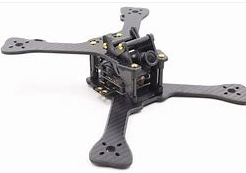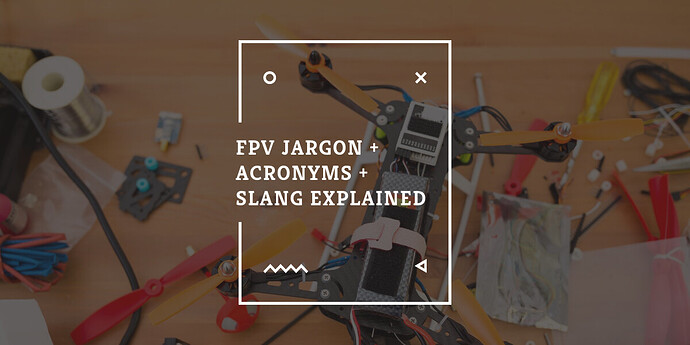Just like any group, there are many unique terms and slang that develops over time, and the FPV subculture is no different. This is a mini guide that I will try to keep updated as a glossary of all the slang, jargon, acronyms that we use in the FPV hobby. If you have anything you would like to add please add your comment and I will get the main guide updated!
This guide is broken down alphabetically to make finding the terms slightly easier, but within each letter grouping, the terms are not alphabetical as that is just too much effort to keep organised.
How to use this guide
To quickly find what a word means you can use the table of contents to alphabetically find the word you are looking for, but you can also use your borwsers build in search too by pressing Control+F and use this text search to look for the word you wish to define.

 Cant find the word you are looking for?
Cant find the word you are looking for?
If you cant find the word, just ask it in this topic and one of us will explain it to you and get it added to this guide.
0 - 9
4-in-1 / 4in1
Fairly self explanatory, but this typically refers to ESC’s, typically used on a quadcopter where it is a single board with 4 ESC built into it, allowing a single board to control 4 motors, hence 4 ESC in 1 board.
It can also be in the context of radio transmitters, as some modules are again a single module with 4 (or more) radio modules inside, allowing it to act like a multifunction/multi-protocol radio module. This could mean that one module can work with Frsky, Flysky, Spektrum and Futaba protocols.
A
Acro Mode
This refers to a flight mode typically found in most drone control firmware. is it also the most common mode used for FPV flying, where is it a manual flight mode where the flight controller will only control the maximum rotation speed about each axis.
Angle Mode
This is a flight mode found on many flight controllers and is often used as a beginner mode as it limits the maximum angle the drone can go to, to prevent it from flipping over and confusing the pilot.
ACC - Accelerometer
A chip found on flight controllers that measures acceleration forces in a specific direction.
ALT - Altitude
AIO - All In One
This is a flight controller that has everything built into it. Typically this is just the flight controller with a 4in1 ESC, but can also include others such as a built in receiver or video transmitter. AIO flight controllers typically have a 25.5x25.5mm mounting size.
Air Mode
A special mode introduced by Betaflight that keeps still alows the motors to react to keep the drone stable even if your throttle stick is at zero.
AC - Alternating Current
American wire gauge (AWG)
This is a common specification used to define the thickness of wires used in drone building. Increasing gauge numbers denote decreasing wire diameters, where larger wire diameters can handle more current.
ARTF or ARF Almost Ready to Fly
An ARTF or ARF model is a pre-built drone that usually includes everything you need to fly, except the radio transmitter and receiver, FPV goggles and battery. However there is no formal standard so its best to check the product description to make sure what it does and does not include.
Arducopter
A popular autopilot software with many advanced features.
Altitude hold
A flight mode on some flight controllers that will maintain the drones current height. It relies on either GPS, pressure ensors or other distance sensor to keep its altitude.
AP - Aerial Photography
AGL - Above Ground Level
This is a relative measurement of altitude above the ground level, typically the takeoff point. Not to be confused with MSL which is an absolute altitude measurement above the sea level.
Ailerons
Ailerons are a hinged flight control surface usually forming part of the trailing edge of each wing of a fixed-wing aircraft.
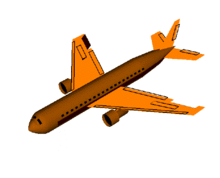
Aux - Auxiliary
This refers to extra channels on your radio control transmitter that are extra to the primary flight controlrs. This could be something like a rotary switch or slider that can be used to control other functions on your drone, such as changing flight modes.
Avatar
This is a digital FPV video system from Walksnail.
B
BNF - Bind and Fly
This is a term used to describe the assembly level of a drone you are purchasing. Often this is also referred to as PNP (Plug and Play), it means that the drone will arrive ready build, and you will just need to either add your own receiver or connect your radio to the one already included. There is no formal standard of this term, so the parts included will differ between manufacturers, so always check the contents before ordering to make sure you get all the parts you need.
Bind
This is the process of connecting a receiver with a transmitter. It often applies to radio controllers, but is also applicable to some FPV systems.
BF - Betaflight
Betaflight is the most popular flight control platform for FPV quadcopters.
Bando
This is an abandoned building, a preferred flying location for freestyle pilots
Balance Charging
This is how lithium batteries need to be charged to ensure that each cell in the battery does not get too much voltage and explode.
Band
This is the frequency of a video transmitter is currently broadcasting on, also referred to as channel.
BEC - Battery Eliminator Circuit
This is a fancy name for a voltage regulator which is a device that accepts a varying voltage input and outputs a consistent voltage.
Baro - Barometer
This is a small pressure sensor that is used to messure air pressure to determin altitude changes
Brushless Motor
Brushless motors are a type of electrical motor that is commonly used in multirotors and drones. They have a wide range of voltage input, more durable and powerful than brushed motors.
Brushed Motor
These are cheaper motors that are often found in small drones. Brushled motors are not as durable or last as long as brushless motors.
Buzzer / Beeper
This is a small speaker that you can use as an alarm to try find a downed drone in long grass. Some ESC’s also have the ability to cause the motors to beep without the need for a separate buzzer.
Bootloader
Special firmware stored in non-volatile memory in a microprocessor that can allow it to connect to a computer to load the main firmware onto the controller.
C
Channel
This usually refers to the frequency band for your FPV video transmitter.
However, it can also reffer command signal from your radio controller. For example throttle is one channel, roll is another channel etc…
CF - Carbon Fibre
CC2500
This is a type of radio transmitter chip that supports protocols such as Frsky and Futaba FHSS
C Rating
This is a measure of a how much current a battery can output. To get the power output in Amps you multiple the battery capacity (in Amp hours) by the C rating to give you the current output.
Cap - Capacitor
Capacitors, or “caps,” are electrical components that are soldered onto ESCs’ power pads or your battery connector. Their purpose is to reduce the amount of electrical noise that is caused by your motors or ESC.
Cinewhoop
This is a small size drone which is designed to be used for film work. It also typically has propeller guards for enhanced safety as they are often used indoors.
Cinelifter
This is a heavy lift FPV drone designed for cinematography. They often use big motors and large propellers 6-10" to lift very heavy cinema grade cameras.
CLI - Command Line Interface
The Command Line Interface, or CLI, is a mode within some flight controller software that let you programaticaly change configuration settings of your drone.
COG / GC - Centre of Gravity
Crossfire
This is a radio control protocol from team black sheep that runs on 915/868Mhz frequency. It is designed for long range as is popular among freestyle FPV pilots due to its good signal penetration.
CW / CCW - Clockwise / Counter-Clockwise
Used in conjunction with propellers or motors, it is the direction they are designed to spin in. its important to note that when used in the context of motors it means that the connector on the motor is wired to make the motor spin in a specific direction, a motor can spin in any direction by changing your ESC settings or motor wire connection order.
Curr / CRT / - Current
Usually found on flight controller pin labels, this is where you would connect a current sensor
D
DSSS - Direct-Sequence Spread Spectrum
DSSS is a type of spread spectrum modulation technique that employs a wide range of frequencies to send data. The name ‘spread spectrum’ comes from the fact that the carrier signals occur over the full bandwidth (spectrum) of a device’s transmitting frequency. In other words, the signal is ‘spread out’ over a larger portion of the frequency than the original data signal. By using more of the available frequencies, spread spectrum signals are less likely to be intercepted and understood by unauthorized users.
DJI
This is a large manufaturer of drones. And for FPV they created the DJI HD FPV system.
DSM / DSM2 / DSMX
This is a radio control protocol used by Spectrum.
DShot - Digital Shot
This is a popular type of ESC protocol to let your flight controller tell the ESC how fast the motors need to spin.
DOF - Degrees of Freedom
Diversity Receiver
This is a type of receiver that is multiple receivers and antennas in one, usually two. This allows it to check the signals from the two or more receivers and switch to the one with the best signal. This lets you mount antennas on different locations, or use different types of antennas.
DFU - Device Firmware Update
As the name suggest, this is a special mode that flight controllers (or microcontrollers specifically) need to be set to in order for the firmware to be updated.
DC - Direct Current
DD - Direct Drive
A type of propeller that is designed to be mounted directly to a motor without gear reduction. In FPV basically all propellers we use are direct drive so you may not come across this term very often, but it is included here for completeness.
E
Exponential (Expo)
Usually applicable when we are talking about PID tuning, or Radio Controller settings/ Expo is applying an exponential response to your stick inputs. This lets you have greater smoothness/accuracy while your stick is near the centre, and as you move your sticks further away, the input is amplified. This in practice allows you to have a quadcopter can be precise when flying gently, but still able to achieve incredibly high roll rates when you move the sticks to the edges.
EMI - Electro-Magnetic Interference
This is the effect of magnetic forces or electronic signals interfering with your hardware.
ESC - Electronic Speed Controller
The ESC is the component that takes a signal from your flight controller (or receiver) and translates this into a voltage that will cause the motor to spin at the desired speed. In short, it’s the thing that controls your motor.
ELEV - Elevator
This is the control surface that controls the pitch of your aircraft.
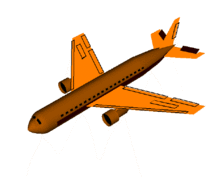
EEPROM - Electronically Erasable Programmable Read Only Memory
A type of non-volatile memory used in flight controllers and other electronic devices to store small amounts of data that must be saved when power is removed, e.g., your configuration information.
ELRS - ExpressLRS
This is an open source radio control protocol that offers great range, penetration and latency. Find out more at the official project page
F
FPV - First Person View
If you dont know what this is you probably should not be here
Freestyle
This is a FPV flying style that involves performing tricks and acrobatics.
Frame
This is commonly used when referring to the part of a drone that holds all the components.
FPV Camera
This is the small camera used to connect to your video transmitter on your drone. The image from this camera is what is sent back to your drone.
Flow
This is a term used to describe a nice smooth flying style by FPV pilots
FC - Flight Controller
This is the flight conputer, or brains of your drone that control everything.
F4 / F7
This is a types of microcontroller processors that is used on many flight controllers. There are many variations such as F405, F411, F722 etc…
Failsafe
This is a safety mechanism that will trigger when certain conditions are met to try minimise loss or damage to your drone
FrSky
Frsky is a radio control protocol created by Frsky.
FOV - Field of View
This is a measurement that defines the angle a camera lens can see.
FW - Firmware
This is a name for the software that runs on a small microcontroller. It’s just like an application on your computer, but since it’s in an embedded application, we call it firmware.
Flash / Flashing
This is the process of installing the firmware onto the microcontroller on your flight controller, receiver, or other electronic module.
FTDI - Future Technology Devices International
The name of the company that makes the electronic chip standard, to convert USB to serial communications. Available as a chip for boards that have a USB connector, or in a cable to connected to breakout pins.
Feed
This is the stream of video you receive from your drone, your video feed.
G
Gap
This is a small opening or space that FPV freestyle pilots like to try and fly through.
Gyro - Gyroscope
A gyroscope, more commonly known as a gyro, is a device that is typically integrated with flight controllers in order to measure a quadcopter’s angular velocity. This information is relayed to the flight controller in order to tell it how the quad is angled and how fast it is rotating. Some flight controllers have more than one gyroscope for increased accuracy.
Ground Effect
Air turbulence when flying close to the ground.
GND - Ground
This is the technical term used for negative or ground of a direct current electrical circuit.
GPS - Global Positioning System
The use of a GPS receiver on the drone will allow the flight controller to track the position and movement of the drone on the earth.
Gimbal
This can be used in two contexts. First this can be a stabilised camera that uses motors to keep the camera stable. Second, it can refer to the stick control assembly of your radio controller.
Ghost
This is a low latency 2.4Ghz radio control protocol.
Ghosting
This phenomenon is when there is some interference between two or more FPV video feeds, and both are overlayed ontop of one another. Not an ideal situation to be in when flying.
Goggles
Also referred to as video goggles or FPV goggles, this is a headset with screens built in that let you view the live video feed from your drone. Some goggles include a receiver built in while others require one to be added or connected to it.
GCS - Ground Control Station
This is the ground part of an autopilot system that tpyicaly includes a computer with a map display that lets you view and interact with your drone.
GIT
A software version control system used by developers
GyroFlow
This is a video stabilisation software that is becoming the default system to use to create ultra-smooth video from footage recorded by your drone. This software supports a very wide range of cameras and drones from GoPro, Insta360, Caddx, Runcam and many more. Check out [GyroFlow Here]( Gyroflow v1.3 is out! | Gyroflow)
H
HDzero
HDZero is a digital FPV system that boasts the lowest latency of all digital systems. However, the drawback of this low latency is the video quality, while still being far superior to analog FPV, is not as good as other HD FPV systems from Walksnail or DJI.
Horizon Mode
Horizon mode is a flight mode ideal for beginners as the aircraft will self-level itself. The mode uses the accelerometer sensor to level the drone.
H7
This is a type of microcontroller processor used on some flight controllers. It is seen as the most powerful processor in terms of computational ability.
Hexacopter
This is a multirotor that uses 6 motors.
Hardware
This is the phyical electronic components of your drone, such as flight controller, electronic speed controller (ESC), etc…
I
IMU - Inertial Measurment Unit
An IMU, or inertial measurement unit, is a device that processes data from the gyro and accelerometer to tell the flight controller the current attitude/motion of the drone.
I2C - Inter-Integrated Circuit
This is a serial bus that is used for some sensors to communicate with the flight controller. This serial protocol is slower than some others such as UART
IPEX
This is a type of connector used for antennas. There are few variations such as IPX, and IPEX4. IPX is smaller, but IPEX4 is the same as U.FL connectors.
iNav
This is a popular flight control firmware that is similar to Betaflight, but aimed more towards fixed wing, and autonomous flight.
J
JST
This is a type of battery connector, usuallyy used with smaller drones and is often red.
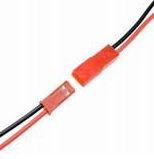
JST-SH
This is a type of connector commonly used on flight controllers to connect other modules such as ESC, GPS modules and recievers.
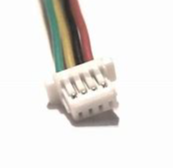
Jello
Undesirable high frequency vibration in flight footage that makes your video look like it is in a bowl of jelly.
K
Kalman Filter
This is the algorithm used in many flight controllers and is responsible for taking accelerometer and gyro data to then give a real-time accurate description of an aircraft’s attitude and movement. This is crucial for pilots who need to know how their multicopter is behaving at any given moment during flight.
kV
This is a measure of a motors RPM per volt with no load (ie no propeller attached). Tpyically lower KV motors are used with higher voltage batteries.
KISS
This is a flight control software and hardware made by Flyduino. It stands for Keep It Simple Stupid
L
Latency
This is the delay from a signal being sent, to it being received. In terms of FPV video, this is the time it takes for the picture form the camera to reach your goggles.
Lines
Not related to substance abuse, lines in FPV refer to the route that you fly. Similar to skateboarding, when you would find your lines through a course.
Other contexts could include when you are talking about wires. For example, if you say your power lines, this can be the wires on your drone responsible for routing power from the battery.
LQ - Link Quality
The concept is similar to RSSI in the sense that is measures the signal quality, but the term Link Quality is specific to Team Black Sheeps Crossfire system and is a more accurate measure of the link between your drone and controller.
Locked in
A term used to describe a drone that has been properly tuned.
LPF - Low Pass Filter
A type of digital filter that blocks higher frequencies
LOS - Line of Sight
This is a type of non FPV flying where you are looking at the drones with your own eyes rather than with video goggles.
LiPo - Lithium Polymer Battery
This is the most popular type of battery used with drones.
LiHv - High Voltage Lithium Polymer
This is a high voltage battery that is designed to hold a slightly higher maximum volage that a typical lithium battery. I would generallyy stay to stay away from these due to an increased risk of fire
Li-ion - Lithium Ion
This is a type of battey that are used on long range quads where you dont need as much high current output since Lion cells have a higher energy density but a lower discharge rate.
LED - Light Emitting Diode
This is a small, efficient light ofen found on electronics, or used for decorative purposes
LC FILTER
An LC filter is a circuit that reduces unwanted frequencies or noise from a power supply. . The L stands for inductor, and C is for capacitor.
LHCP - Left Hand Circular Polarisation
LHCP refers to the type of polarisation of an antenna. For more information please see The complete guide to FPV antennas for your drone
M
Magic Smoke
The special smoke that is released when you short circuit your electronics. Also known as sparky the magic smoke monster.
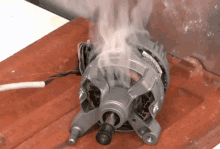
MTOW - maximum take-off weight
This is the maximum weight of your drone that it can still take off with.
MCU - Microcontroller
This is the small processor found on many electronics such as flight controllers, ESC, recievers etc…
Multishot
A type of analogue ESC protocol to replace Oneshot
MAG - Magnetometer or Compass
This is a electronic compass sensor that uses the earth’s magnetic field to know what direction the flight controller is pointing in.
mAh - milli Amp Hours
This is the capacity rating of a battery
MSL - Mean Sea Level
This is an absolute measurement of altitude above sea level. Not to be confused with AGL which is a relative altitude measurement above the ground level.
MMCX
MMCX is a type of antenna connector typically found on radio receivers and video transmitters due to their small connector size.
Mode (mode 1, or mode 2)
This term is used to describe the stick layout of your radio controller, Mode 1 has throttle on the right, whereas mode 2, which is the most common has the throttle on the left.
Motor
This is the metal spinny thingy on your drone that goes brr
MOSFET / FET
This is a chip that is essentially a very fast switch that is used on electronic speed controller (ESC) to control your motor.
N
Naked GoPro
This is the result of taking a gopro camera, stripping all the nonessential parts from it, to make an ultra-lightweight version designed to be used on smaller drones where you want high quality footage. Typically used on 2-3" drones.
NC - Not Connected
You may find this term on pinouts, or connector labels and this means that this pin is not connected to anything, or not used.
NTSC
This is the analogue video standard commonly used in USA
O
OSD - On Screen Display
This is a graphical display that is overlaid on top of your FPV video feed.
Oscillation
Like the name suggests, this is the term used to describe how a drone may wobble if it has not been tuned correctly.
Octocopter
This is a type of multirotor drone that has 8 motors.
Opto ESC
This is an ESC without a battery eliminating circuit (BEC), or in normal words, without any voltage regulator that can be used to power other things such as your flight controller.
Oneshot
This is a protocol used on your ESC that is better than pulse width modulation (PWM)
P
Pack
This is the term used for your battery, or battery pack used on your drone.
Punch
This is when you rapidly increase throttle of your drone. Can also be used as Punch Out
Payload
This is the equipment that your quad carried in addition to the basic parts required to fly. You can think of it as anything that is removeable. So this will include things such as the flight battery, your action camera.
PX4
This is a popular autopilot firmware that has many advanced features.
PAL
This is an analogue video standard, commonly used in Europe. The main reason for this is that the other common standard NTSC is the same frequency as the EU power grid frequency, so sometimes when flying indoors you will notice more flickering if you are NTSC in the EU.
PCB - Printed Circuit Board
This is the base copper/fibreglass board that electronic components are mounted to. It has copper traces to connect the various components on it.
PNP - Plug and Play
This is a term used to describe the assembly level of a drone you are purchasing. Often this is also referred to as BNF (Bind and Fly), it means that the drone will arrive ready build, and you will just need to either add your own receiver or connect your radio to the one already included. There is no formal standard of this term, so the parts included will differ between manufacturers, so always check the contents before ordering to make sure you get all the parts you need.
Pigtail
This is an antenna wire/connector that is often used as an extension. It can be used to extend your battery lead, or also to extend your antenna. Some examples are shown below:
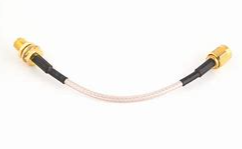
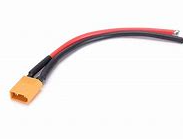
Prop (Propeller)
This is the propeller of the drone. This is the spinny blade like thing that helps keep a quadcopter in the air, or propel a fixed wing aircraft forward.
Prop Wash
This is a phenomenon that you can experience with a multirotor, particularly when descending where the propeller hit its own turbulent air causing your drone to wobble.
Pitch
This is usually the measure of the angle of a propeller blade. Pitch is measured in inches, and this value is the distance the propeller will travel in one complete revolution. The steeper the pitch the more aggressive the prop will be as it will push more air per rotation. Pitch can also be used to describe the angle an aircraft is flying at.
Power Train
In FPV the powertrain refers to the parts that drive your drone. This includes the propellers, motors, speed controllers, and battery.
Polarisation
The polarisation is used in the context of antennas. This refers to the radiation type for an antenna. The main thing to note here is that you want the same type of polarisation on both your transmitter and receiver antennas to ensure they will work well together. For more information please check this guide FPV Antenna Fundamentals
PDB - Power Distribution Board
This is a board that as the name suggest, will distribute power on your drone to the various sub systems and modules. It is not common to find this on a quadcopter anymore, since most 4in1 ESC’s include this built into it.
PWM - Pulse Width Modulation
This is an analogue communication protocol, commonly used on receivers and servos, and some ESC’s where each channel requires its own wire.
PPM - Pulse Position Modulation
This is a communication protocol, typically used with receivers, where it can send several channels of data along a single wire.
PID Controller - Proportional, Integral, Derivative
A PID controller is an algorithm used to control your drone based on your control inputs from your radio controller. For more information, please see this explainer video
PID Tuning
This is the process of optimising the terms in the PID controller to achieve the best possible flight performance.
Power Loop
A FPV trick where a pilot flies through a gap, does a loop over it and flies back through the same gap in a seamless maneuverer.
Q
Quad / Quadcopter
This is the term used to describe a multirotor drone that has 4 motors. This is the most common type of FPV drone.
R
Rip It
This is when you fly your quad in a very enthusiastic manner. Or when you give it the beans. Other variations include nice Rip as a compliment or lets Rip if you want to fly with a buddy.
Rate
The rate is the settings on your drone that will define how fast/sensitive it will move in response to your control inputs. In a quadcopter setting, this will define the maximum roll speed around each axis your drone can spin. It’s akin to adjusting your mouse sensitivity in a first-person shooter game.
RP-SMA
RP-SMA is a type of antenna connector, usually used on video transmitter and Goggles. The table below will help you to identify the types of SMA and RP-SMA antennas
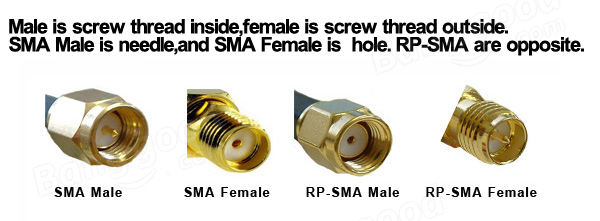
RSSI - Received Signal Strength Indication
The RSSI is a measure of the radio link quality. Most receivers include this feature and can send this information back to the flight controller which in turn can dispaly this to the Pilot. This measurement is usefull as if it gets low, the pilot can be alerted to turn back before they loose control of the drone. Some drones will also have an added safety feature that if the link is lost (RSSI becomes 0) they drone will enter a recovery mode and return back to the home location (see RTH definition).
Radio Control (R/C or RC)
Depending on the context, it can refer to the radio control hobby in general, or it can also refer to the radio controller. This is the device you use to control or fly your drone with two sticks, also sometimes referred to as the RC controller.
RCG - RC Groups
This reffers to the biggest radio control forum on the internet (RCgroups.com)
Radio Frequency (RF)
This is the term used to describe the frequency of your radio equipment. In this hobby you will come across 2.4Ghz which is mostly use for radio control, 5.8Ghz which is most often used for video feeds. Some long range radio control system or telemetry will use 868/915Mhz. Its also worth noting that 915Mhz is not legal to be used in the EU.
Receiver (RX)
The RX is term used for your radio control receiver. This is the small module that is onboard your drone that receives the control signals from the RC controller, and in turn passes this signal onto your flight controller.
RPM - Revolutions Per Minute
This is a measure of the rotational speed of a motor in 60 seconds.
Remote ID
The Remote ID or RID is a term used in the USA at the moment which is a regulation of the FAA that all drones will need a transmitter module that will broadcast information about the drone such as its position, altitude etc…
RHCP - Right Hand Circular Polarisation
RHCP refers to the type of polarisation of an antenna. For more information please see The complete guide to FPV antennas for your drone
RTH - Return to Home, RTL - Return to Launch
This is a feature available with many flight control systems that will allow the drone to fly back to the home point automatically. This requires a GPS module in order to function. The autonomous levels of this function will depend on the type of autopilot used, some will just fly to the approximate location, while others have the ability to fly back, avoiding obstacles and landing in the takeoff spot all on its own.
Rudder
Also known as Yaw, often depicted as R in channel mapping of various flight controller configurators
Ready To Fly (RTF)
This is a term used to indicate the amount of equipment included with a drone. It is important to note that despite the name, the drone may not actually be ready to fly out of the box as you may need to do some configuration. There is no formal standardisation of the term either, so some RTF kits may still require things like a battery or charger. But in general, its accepted that Ready To Fly will include the drone, controller and FPV goggles.
ReelSteady
This is a stabilisation software popular among FPV pilots that help stabilise any footage recorded from a GoPro camera onboard your drone. This can only be used with GoPro cameras, so if you are using another camera you can also have a look at GyroFlow, an open source alternative.
S
Servo (Servomechanism)
A servo is a small motor driven system that will move depending on the command it is sent. Typically used on fixed wing drones to move control surfaces. This is usually connected to either your R/C receiver or flight controller.
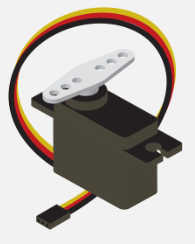
Send It
This is FPV slang for aggressively taking off with your drone at full power. As an example, just before your friend is about to take off, you would look to him and enthusiastically say, “Send It” before the drone shoots of into the sky.
Stator
This is the part of a motor that does not rotate, or stationary. In FPV stator is mainly used in context to the size of a motor that give it an indication of its power. Stator sizes are defined by their height and diameter, with large stator volumes indicating a more power motor.
Standoff
Stand-offs are like screws, but different. They can be made from metal or plastic. These are typically used to mount your electronics (flight controller or ESC) to the frame of your drone. They also allow you to stack boards on top of each other to form a flight stack.
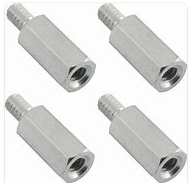
Spacer
Similar to standoffs, but without any screw parts, spacers are used to separate boards on your flight stack.
Stack (Flight Stack)
A Flight Stack, or FC Stack, or just Stack, is the term used to the combination of your flight controller, speed controller and other items such as a video transmitter that are all mounting in a tower using standoffs on your drone.
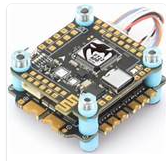
SMA
SMA is a type of antenna connector, usually used on video transmitter and Goggles. THe table below will help you to identify the types of SMA and RP-SMA antennas

SBUS (Serial Bus)
Serial Bus or SBUS (can also be written as S.BUS) is a type of protocol uset to communicate between your receiver and flight controller, and also in some cases servos. Created by Futaba, and commonly used by Frsky systems too.
Sub250
This is a class of drone that has a total weight less than 250g (including battery). It was originally defined by various regulatory bodies (in USA and Europe) as the maximum weight of a drone before it needs to be registered.
Smart Audio (SA)
Smart Audio is a protocol developed to allow your video transmitter to communicate with your flight controller. This means that you can change channels, power levels on your FPV transmitter remotely which is very convenient.
S (Cell Count/ Battery Voltage)
When talking about batteries you will commonly see terms like 4S or 6S etc… this refers to the cells in a battery, or more directly the voltage. This is important mainly when choosing components as certain things will only be compatible with certain voltages. As a general guide you will find 1S, 2S, 3S, 4S, 5S, and 6S in the FPV hobby with 4S and 6S being the most common. To get the actual voltage you would multiply the number by 3.7 to get the voltage.
Spotter / Visual Observer (VO)
This is a person who is not piloting a drone but is in communication with the pilot of the drone. A spotter is responsible for making sure the environment around the drone is safe for flight and will alert the pilot for any risks such as people walking, other aircraft etc… Essentially a second pair of eyes.
Super Rates (Super Expo)
Super Rates is an old term used in Betaflight firmware which has now been renamed to just Rate. This essentially increases the maximum sensitivity of your drone to your stick inputs around the center stick area. For more details see Exponential.
SF - Slow Fly
A type of propellers that are designed to work best as slower rotational speeds
T
Transmitter (TX)
TX is the acronym used for Transmitter. When you see the term TX, it usually refers to the radio signal transmitter that broadcasts a signal, typically your radio control signal, but can also be reffering to a telemetry signal aswell. When refferting to your FPV transmitter we use the term VTX, for video transmitter.
Tracer
This is a 2.4Ghz radio control protocol created by Team Black Sheep (TBS). It is a high speed signal that is popular among FPV racers.
Telemetry
Telemetry is a real time stream of sensor data from your drone. This can be one way or two way depending on the telemetry system. This telemetry information can be used by other systems or even used to be displayed on top of the video feed to give the pilot some readings of the drones speed, voltage, motor RPM etc…
Tiny Whoop
Tinywhoops are a class of quads that are smaller in size compared to other drones. They are mostly ducted, making them ideal for indoor use. They can take quite a few hits before going down, and are cheap to repair making them perfect for beginners. In terms of propellers, tinywhoops usually use 1" to 2" props.
Toothpick
This is a small, lightweight class of drone that still aim to have aggressivee acrobatic capabilities. The term stems from the early designs that had very skinny arms. Due to the small size these drones will typically use an All in One (AIO) flight controller that has for the flight controller and ESC components on a single board with mounting holes of 25x25mm
Thrust
Thrust is the term we use for the force generated my a drones power system (motors and propellers attached to them). Typically measured in grams
Throttle
This is the stick input that controls how fast you want your motors to spin, in other works your throttle stick controls your drones thrust.
Turtle Mode
This a flight mode that allows you to reverse the directions of your motors to help flip the drone over it is stuck on the ground on its back, hence like a turtle stuck upside down on its shell.
TVL - Television Lines
This is a term used to define the resolution of an analog FPV system. Typical resolutions are around 1000-1200TVL
Tune
This is the process of optimising the settings and configuration of your drone, so it flies at optimal performance.
TAER1234
This is a common channel mapping used with flight controller configurations such as BetaFlight. T stands for Throttle (thrust), A is for aileron (roll), E is for elevator (pitch), and R is for rudder (yaw)
Tricopter
This is a multirotor drone that has 3 motors. The rear third motor also uses a servo to tilt the motor to control yaw.
U
UART - Universal Asynchronous Receiver and Transmitter
UART is a serial communication port found on many flight controllers we use in FPV. They are used to connect peripherals like receivers, GPS modules to your drone. Kind of like USB but for flight controllers.
UBEC - Universal Battery Elimination Circuit
This the technical term for a voltage regulator, a device that will take an range of input voltages, and output a constant voltage.
U.FL (IPEX4)
UFL is a type of connector used on many antennas. Due to the small size they are ideal for use on small video transmitters, or receivers. UFL connectors are the same size as IPEX4 connectors and can be used interchangeably.
Ultra Light
This is a type of quadcopter that, as the name suggests, is very lightweight, typically falling into the sub 250g weight class. Here the quadcopters main focus is long flight times and is typically not extremely
Unmanned Aircraft (UA), Unmanned Aeiral Vehicle (UAV), Unmanned Aircraft Systems (UAS)
This is the term used to describe a flying vehicle that is controlled remotely, or autonomously.
Unmanned Ground Vehicle (UGV), Rover
This is the term used to describe a ground vehicle that is controller remotely, or autonomously. Ie a robot.
V
Video Transmitter (VTX)
A VTX is a video transmitter, the device that us used to transmit the image from a camera connected to it. A VTX can be other analog or digital, but usually when people talk about digital VTX, they often refer to them as Air Units, or Digital VTX to make the distinction between the two.
Video Receiver (VRX)
A VRX is the module that will receive the signal broadcast form the VTX, and is ofen built directly into the video goggles or monitor.
VCC
This is a technical term used for positive voltage input.
V-tail
This can either describe the tail arrangement of a fixed wing drone (where it forms a V shape). Or in the case of multirotor drones, this is a quadcopter where the motors from a V shape from above.
VTOL - Vertical take off and landing
A term used to describe aircraft that can take of and land vertically, like a helicopter, but also fly forward like a traditional fixed wing aircraft. Think of a AV8 harrier jump jet, or an F35-B.
W
Walksnail
This is a manufacturer of the Avatar digital FPV system used by many FPV pilots. Not to be confused with the Avata drone by DJI.
WOT - Wide Open Throttle
Full throttle, or 100% throttle.
X
XT30, XT60, XT90
This is a common type of battery connector used with FPV drones. The number represents the size of the connector and the current it can handle. So, you find XT30 connectors on smaller quadcopters and XT60 on most 5" size drones, and XT90 on larger drones. A picture of an XT60 connector is shown below.
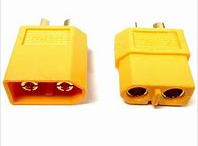
X8
A type of mulirotor that has 8 motors, but in a quadcopter like arrangement where motors are one above the other.
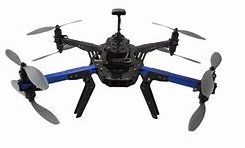
Y
Y-Cable
This is a servo cable typically used on the wings of R/C aircraft to splits a command signal from your receiver or flight controller. Used on the ailerons to roll the aircraft, the Y-Cable inverts the commands so that one servo will move up while the other moves down, causing the aircraft to roll.
Y6
A type of multirotor drone that is like a double decker tricopter, where it has 3 pairs of motors stacked vertically.
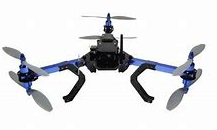
Z
Z Frame
This is a very obscure layout of a drone frame where the rear motors are well above the front motors to form a Z shape from the size.
